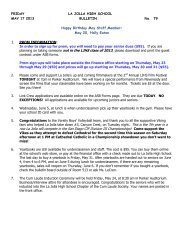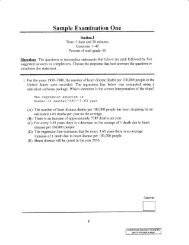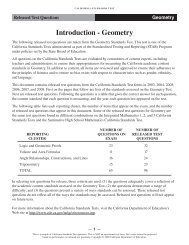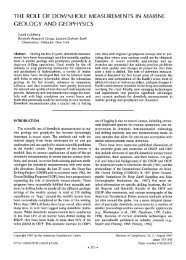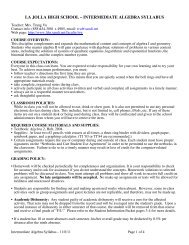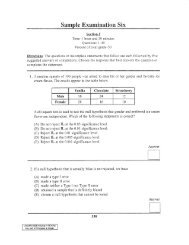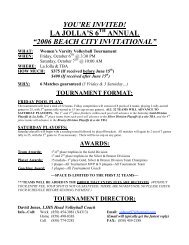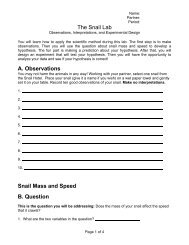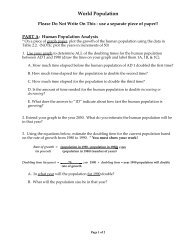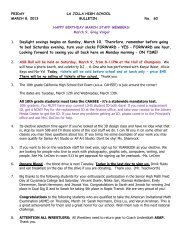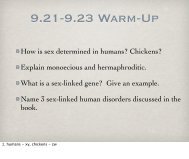Create successful ePaper yourself
Turn your PDF publications into a flip-book with our unique Google optimized e-Paper software.
A PEOPLE and A<br />
NATION<br />
EIGHTH EDITION<br />
Norton • Katzman • Blight •<br />
Chudacoff • Paterson • Tuttle •<br />
Escott • Bailey • Logevall<br />
<strong>Chapter</strong> <strong>27</strong>: The<br />
Second World War at<br />
Home and Abroad,<br />
1941–1945
Ch. <strong>27</strong>: WWII at Home and Abroad,<br />
1941–1945<br />
• Turning point for USA & its people<br />
• Change status of USA in world<br />
• Allied cooperation tenuous throughout<br />
war<br />
• Home front change with migration<br />
• New race/gender/economic opportunities<br />
• US Gov’t mobilize industry, labor,<br />
science, & technology for war<br />
Copyright © Houghton Mifflin Company. All rights reserved. <strong>27</strong> | 2
I. A Nation Unprepared<br />
• Despite pre-war rearmament, USA not ready<br />
• War initially not go well for Allies<br />
• Hitler dominate Europe by late 1941<br />
• Japan expand rapidly at start of Pacific war<br />
• Capture Southeast Asia, incl. Philippines<br />
• Doolittle raid convince Japan to seek<br />
Midway<br />
• Key US advantage = MAGIC intercepts<br />
• Midway (June 1942) turn tide of Pacific war<br />
Copyright © Houghton Mifflin Company. All rights reserved. <strong>27</strong> | 3
II. Europe First Strategy<br />
• FDR pursue Europe First strategy<br />
• If Hitler win Europe, could directly<br />
threaten USA<br />
• Tensions among 3 major allies = another<br />
problem<br />
• Fear separate peace by USSR<br />
• Stalin want second front in France ASAP<br />
• Relieve German pressure on USSR<br />
• Churchill oppose second front<br />
Copyright © Houghton Mifflin Company. All rights reserved. <strong>27</strong> | 4
III. Second Front Controversy<br />
• Churchill fear high causalities of invasion<br />
• Want operations to protect British empire<br />
• FDR initially side with Churchill<br />
• Agree to invasion of N. Africa (1942)<br />
• Stalingrad (1942–43) = turning point<br />
• USSR stop Hitler’s army<br />
• Begin German retreat from USSR<br />
Copyright © Houghton Mifflin Company. All rights reserved. <strong>27</strong> | 5
IV. The Production Front: Business<br />
• FDR see mass production as key US<br />
advantage<br />
• War Production Board (1942) oversee<br />
conversion to wartime economy<br />
• WPB guarantee profits in “cost + fixedfee”<br />
contracts as well as generous tax<br />
deductions<br />
• Corporate profits double, 1939-1943<br />
• Big business grow bigger as ⅔ of all<br />
WPB contracts go to 100 largest<br />
businesses<br />
Copyright © Houghton Mifflin Company. All rights reserved. <strong>27</strong> | 6
V. Universities & War; Opportunities<br />
for Workers<br />
• Big US Gov’t grants mobilize higher ed for war<br />
• $117 million to MIT; Manhattan Project = $2<br />
billion<br />
• Universities join new military-industrial complex<br />
• Massive labor shortage<br />
• Increase production while withdraw 16 million<br />
• New jobs for women, African Americans,<br />
Mexican Americans, & poor whites from South<br />
• Business resist change (hiring blacks, women)<br />
Copyright © Houghton Mifflin Company. All rights reserved. <strong>27</strong> | 7
VI.Opportunities for African<br />
Americans & Mexicans<br />
• Blacks resist discrimination w/ protest<br />
• Randolph & proposed March on DC, 1941<br />
• FDR issue order to ban discrimination in<br />
hiring for defense industries & US Gov’t<br />
• New defense jobs spur 1.5 million blacks<br />
to migrate from South to cities in North &<br />
West<br />
• US Gov’t encourage Mexican<br />
immigration<br />
• Gain jobs, but like blacks, Mexicans<br />
suffer discrimination & segregation<br />
Copyright © Houghton Mifflin Company. All rights reserved. <strong>27</strong> | 8
VII. Women at Work<br />
• Over 6 million women enter workforce<br />
• Unlike 1930s, women workers receive<br />
praise<br />
• Many women (both white & black) enter<br />
traditionally male jobs (riveters, welders)<br />
• Some businesses offer workers<br />
healthcare<br />
• US Gov’t fund childcare centers<br />
Copyright © Houghton Mifflin Company. All rights reserved. <strong>27</strong> | 9
VIII. Organized Labor; Success on<br />
Production Front<br />
• Unions work with US Gov’t via no strike<br />
pledge<br />
• National War Labor Board (NWLB)<br />
mediate union/management conflicts<br />
• Union membership almost double<br />
• Strikes occur when NWLB limit raises<br />
• US Gov’t pass War Labor Disputes Act<br />
(1943)<br />
• Mass production achieve huge increase<br />
in key war products (planes, ships, etc.)<br />
Copyright © Houghton Mifflin Company. All rights reserved. <strong>27</strong> | 10
IX. Life on the Homefront<br />
• Mobilization end Depression, spur<br />
prosperity<br />
• Americans volunteer help (victory<br />
gardens)<br />
• Office of Price Administration (OPA)<br />
institute rationing of key goods (food, gas)<br />
• To ensure support, Office of War<br />
Information (1942) sell war at home<br />
• Near unanimous support for war; popular<br />
culture see it as fight for US way of life<br />
Copyright © Houghton Mifflin Company. All rights reserved. <strong>27</strong> | 11
X. Wartime Prosperity<br />
• Employment, wages, & savings skyrocket<br />
• OPA set prices to control inflation<br />
• US Gov’t finance war with deficits<br />
• US debt balloon ($49 billion to $259 billion)<br />
• Map <strong>27</strong>.2: 15 million people move during war<br />
• Strain resources of burgeoning cities/towns<br />
• Some in North dislike poor whites from<br />
South<br />
Copyright © Houghton Mifflin Company. All rights reserved. <strong>27</strong> | 12
XI. Racial Conflicts<br />
• Competition (jobs/housing) increase<br />
tension<br />
• Mobs of whites attack African Americans<br />
• 250 race riots (1943); worse one in<br />
Detroit<br />
• Mexicans suffer LA zoot suit riots (1943)<br />
Copyright © Houghton Mifflin Company. All rights reserved. <strong>27</strong> | 13
XII. Families in Wartime<br />
• 3 million families suffer wartime<br />
separation<br />
• Marriage & birth rates soar (“goodbye<br />
babies”)<br />
• More divorces too as hasty marriages<br />
unable to survive strains of war<br />
• Working mothers suffer criticism that they<br />
neglect children (“victory girls”)<br />
• Some males vets have trouble accepting<br />
new independence in their wives<br />
Copyright © Houghton Mifflin Company. All rights reserved. <strong>27</strong> | 14
XIII. The Limits of American Ideals<br />
• Tension between ideals and wartime practices<br />
• US Gov’t use censorship & some propaganda<br />
de-humanize enemy, but less then WWI<br />
• US Gov’t intern 14,426 Europeans on spy fears<br />
• Intern 112,000 Japanese Americans (most US<br />
citizens) as “enemy race”<br />
• None ever charged with treason; some enlist in<br />
military; internees lose homes/businesses<br />
Copyright © Houghton Mifflin Company. All rights reserved. <strong>27</strong> | 15
XIV. Segregation at Home and in<br />
Military<br />
• NAACP grow & advocate “Double V”<br />
• Focus on parallels (Axis racism with Jim<br />
Crow)<br />
• CORE (1942) begin nonviolent direct<br />
actions<br />
• 887,000 black men & women serve in<br />
war<br />
• Serve in segregated, usually service,<br />
units<br />
• Red Cross segregate blood<br />
• Military resist integration<br />
Copyright © Houghton Mifflin Company. All rights reserved. <strong>27</strong> | 16
XIV. Segregation at Home and in<br />
Military (cont.)<br />
• Navy disregard safety of black sailors,<br />
CA, ‘44<br />
• Black soldiers suffer violence by white<br />
soldiers & civilians<br />
• Black combat units perform well (pilots)<br />
• WWII = turning point for civil rights<br />
Copyright © Houghton Mifflin Company. All rights reserved. <strong>27</strong> | 17
XV. America and the Holocaust<br />
• Most tragic failure to live up to US ideals<br />
• Hitler murder 11 million Jews,<br />
“undesirables”<br />
• Allies not attack Nazi death camps from<br />
air<br />
• Not till 1944 does USA help save<br />
200,000 Jews<br />
Copyright © Houghton Mifflin Company. All rights reserved. <strong>27</strong> | 18
XVI. Life in the Military<br />
• Over 15 million men (draftees = 10 million)<br />
• War broaden horizons; vets make contact with<br />
different races, ethnic groups, regions<br />
• 350,000 women volunteer as clerks/nurses<br />
• Poor whites compose most combat units<br />
• Combat = carnage from high tech weapons<br />
• 300,000 combat deaths; 1 million wounded<br />
Copyright © Houghton Mifflin Company. All rights reserved. <strong>27</strong> | 19
XVII. War in Europe<br />
• USA & England continue to delay 2nd Front<br />
• Strain relations between Allies<br />
• At Tehran (1943) FDR overrule Churchill<br />
• Set cross-channel invasion for 1944<br />
• D-Day (June ‘44) = largest amphibious<br />
landing<br />
• USA/ England move in from west as USSR<br />
invade Germany from east (Map <strong>27</strong>.3)<br />
• USA/ England win Battle of Bulge (1944–45)<br />
Copyright © Houghton Mifflin Company. All rights reserved. <strong>27</strong> | 20
XVIII. The Yalta Conference<br />
(Feb. 1945)<br />
• England want to preserve empire<br />
• USSR want reparations to help rebuild<br />
• Also want Poland as buffer against<br />
Germany<br />
• Install pro-USSR government in Poland<br />
• USA want to avoid errors of WWI peace<br />
• Want to advance self-determination & US<br />
power<br />
• FDR want 4 Policemen to guide world<br />
Copyright © Houghton Mifflin Company. All rights reserved. <strong>27</strong> | 21
XVIII. The Yalta Conference (cont.)<br />
• Military positions shape settlement<br />
• USSR dominate E. Europe, esp. Poland<br />
• Each of the Big 3 compromise<br />
• Set up new UN; strong Security Council<br />
(4 Policemen) & weak General Assembly<br />
• Stalin agree to enter war against Japan<br />
• Also allow France a German/Berlin zone<br />
• Sign treaty with pro-US Jiang<br />
Copyright © Houghton Mifflin Company. All rights reserved. <strong>27</strong> | 22
XIX. Harry Truman<br />
• FDR pick inexperienced Truman as VP in<br />
1944<br />
• Germany surrender May 1945<br />
• After death of FDR (April) & defeat of<br />
Hitler, less cooperation between Allies<br />
• Each of Big 3 jockey for influence<br />
• HST less patient with USSR at Potsdam<br />
(July)<br />
• With atomic bomb, USA has less need of<br />
USSR<br />
Copyright © Houghton Mifflin Company. All rights reserved. <strong>27</strong> | 23
XX. War in the Pacific<br />
• USA fight in carrier battles & difficult<br />
“island-hop” invasions against Japan<br />
• USA take Solomon, Gilbert, Marshall,<br />
Mariana islands and retake Philippines<br />
(1942–44)<br />
• USA attack Japanese shipping to disrupt<br />
flow of vital war materials/supplies<br />
• At Iwo Jima (Feb/Mar 1945) both sides<br />
suffer huge losses; same at Okinawa<br />
(April/June)<br />
Copyright © Houghton Mifflin Company. All rights reserved. <strong>27</strong> | 24
XXI. Bombing of Japan<br />
• Fire bomb of Tokyo (May 1945) kill 100,000<br />
• Bombing in first ½ of ’45 kill almost 1 million<br />
• Japanese leaders reject unconditional<br />
surrender (especially on Emperor)<br />
• Extensive bombing during WWII = context<br />
to understand US decision to use atomic<br />
bombs<br />
• Bombing of civilians widespread in WWII<br />
• 225,000 die at Dresden, Feb. 1945<br />
Copyright © Houghton Mifflin Company. All rights reserved. <strong>27</strong> | 25
XXII. The Atomic Bombs (August 6<br />
and 9, 1945)<br />
• With massive blast, fires, & radiation,<br />
130,000 die at Hiroshima; 60,000 at<br />
Nagasaki<br />
• Primary goal of Manhattan Project = end<br />
war ASAP & save US lives<br />
• Truman & others want to avoid invasion<br />
of Japan<br />
• Reject peace feelers as unlikely to make<br />
Japan surrender fully<br />
Copyright © Houghton Mifflin Company. All rights reserved. <strong>27</strong> | 26
XXII. The Atomic Bombs (cont.)<br />
• Anger at Japanese “beasts” (Pearl<br />
Harbor, Bataan March) affect<br />
Truman/others<br />
• US leaders also assume monopoly on A-<br />
Bomb will benefit postwar USA<br />
• Might deter postwar aggression<br />
• Might encourage USSR concessions (E.<br />
Europe)<br />
• Might end Pacific War before USSR entry<br />
Copyright © Houghton Mifflin Company. All rights reserved. <strong>27</strong> | <strong>27</strong>
XXIII. Effect of WWII<br />
• 55 million soldiers & civilians die in WWII<br />
• USSR lose 21 million<br />
• USA escape war’s devastation<br />
• Emerge as dominate economic/military<br />
power in world<br />
• WWII change USA at home & abroad<br />
Copyright © Houghton Mifflin Company. All rights reserved. <strong>27</strong> | 28
Summary: Discuss Links to the<br />
World & Legacy<br />
• War brides as new link between USA &<br />
world?<br />
• 60,000 US men marry foreign women<br />
• Most adjust to USA, but some face racism<br />
• Fears of nuclear proliferation as a legacy<br />
of WWII?<br />
• Why do some skeptics see “hypocrisy” in<br />
Non-Proliferation Treaty?<br />
• Current “nightmare scenario” on nuclear<br />
use?<br />
Copyright © Houghton Mifflin Company. All rights reserved. <strong>27</strong> | 29



